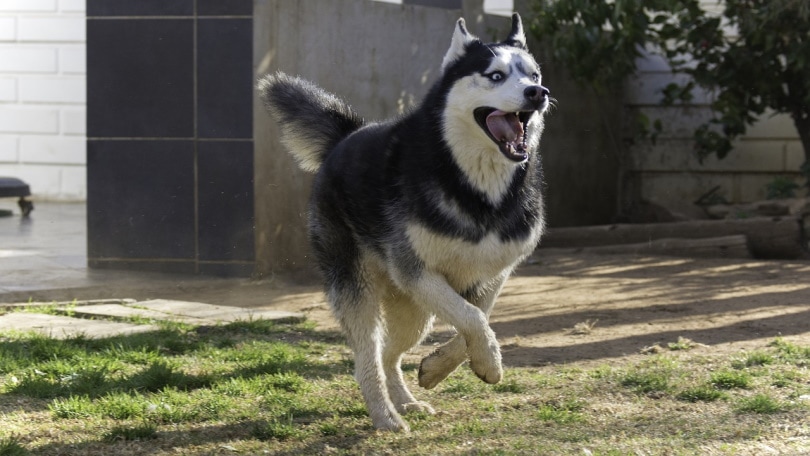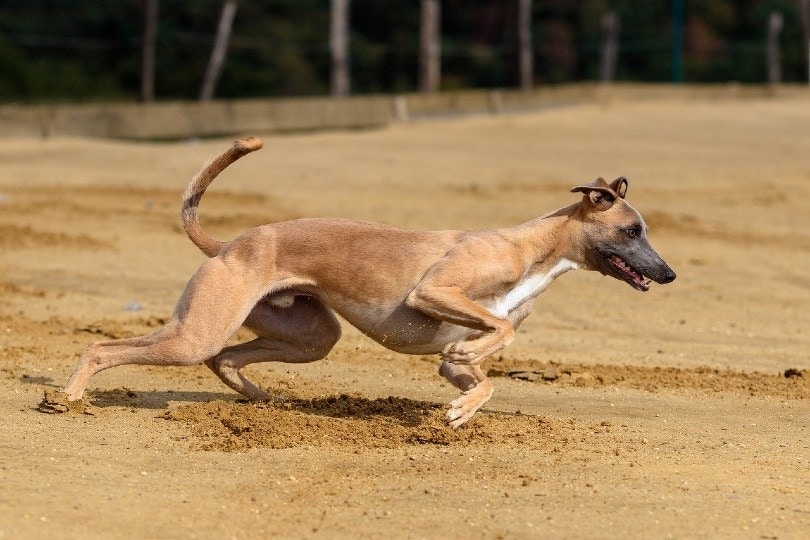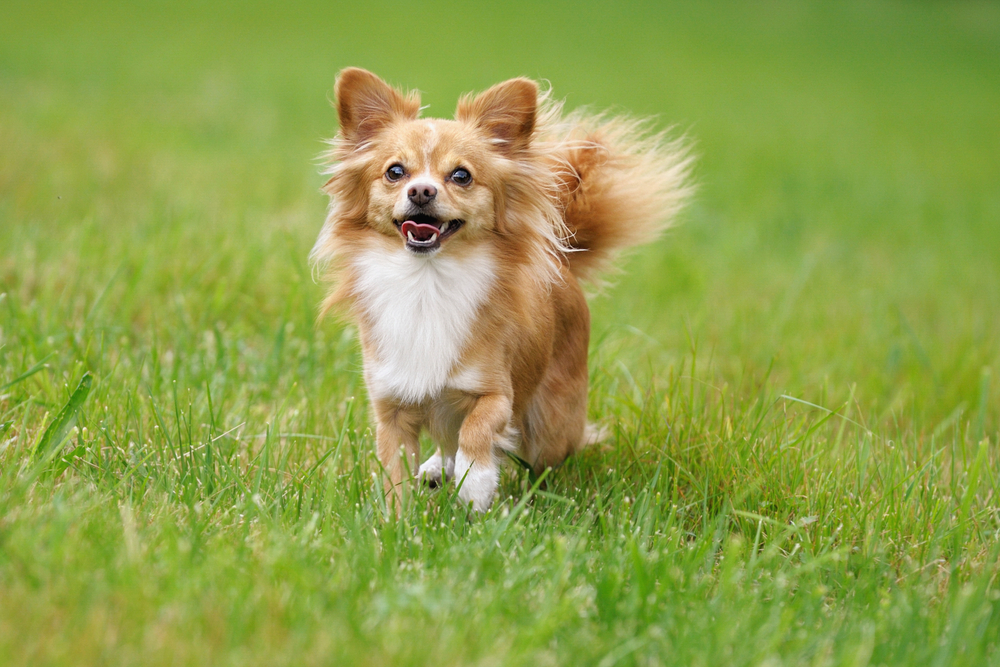You already know that your dog is fast, but have you ever wondered just how fast they are? As it turns out, the answer isn’t easy to give in a single sentence because the dog’s speed depends on their breed. For example, Greyhound, the fastest dog, can run up to 45mph.
One thing that we can tell you for sure is that you probably shouldn’t challenge your dog to a footrace.

How Fast Are Dogs?
Some dogs, like Greyhounds, are incredibly fast, while others, like Pugs, aren’t fast at all. It’s impossible to give a one-size-fits-all answer to this question, and what do we mean by “fast?” That usually means the highest top-end speed that an animal can generate, often over short distances. That can be a bit misleading, though.
For example, most people would say that a champion sprinter is faster than a record-setting marathoner. However, the marathoner would undoubtedly run farther than the sprinter could manage.
So, while Greyhounds will cover a few hundred meters faster than any other breed, they probably can’t keep up with an Australian Shepherd on a several-mile-long run.

How Fast Can Fast Dogs Run?
Greyhounds are the fastest dog breed, but how fast are they? A Greyhound’s top speed is somewhere in the vicinity of 45 mph, which is enough to put them in rare company among land animals. Only a handful of species can boast faster top-end speeds, such as cheetahs, quarter horses, and (surprisingly enough) ostriches.
While Greyhounds hold the crown among canines, they’re far from the only fast canines. Salukis can hit 42 mph, Jack Russells are capable of 38 mph, and German Shepherds are often clocked at 30+ mph.
One characteristic that all these fast pups have in common is that they were either bred to run down prey like foxes or deer or help tend to other animals. This requires them to be quick and agile, and they have retained those traits even if they rarely get to use them for their original purposes.

What About Slow Dogs?
Some dogs can barely reach anything that could be considered a sprint, and they are among the slowest land animals on the planet. These include Basset Hounds, Pugs, and Chihuahuas, all of whom stay at around 5 mph. Other slowpokes include Shih Tzus (6 mph), Toy Poodles (10 mph), and English Bulldogs (15 mph).
As you can see, most of the slower dogs are also smaller dogs. They don’t have the long limbs necessary to generate high top-end speeds, but many of them are extremely quick and agile over short distances. Most of the slower breeds were designed for more stationary pursuits.
Many are lap dogs, while others, like Basset Hounds, were bred to track prey over long distances rather than run them down in the short term. Basset Hounds are also prized for their powerful senses of smell, so they don’t need to run too fast, lest they miss an important odor.

Which Breeds Are Distance Runners?
Some dogs are endurance athletes rather than sprinters. While they may not be able to match Greyhounds over short distances, they can cover an entire countryside in just a few hours while the Greyhound struggles to keep up.
Most marathon breeds are larger dogs that can maintain speeds of around 15 mph for hours at a time. These include Labradors, Siberian Huskies, and English Setters. The dog’s origins will hold clues to how fast they can run. Labradors and English settlers are hunting dogs, so they’ll need to be able to spend an entire day fetching their quarry. On the other hand, Siberian Huskies were designed to pull sleds, so they need to be powerful and reliable rather than capable of short bursts of speed.

What Can Limit a Dog’s Speed?
A dog’s physical makeup plays a large role in determining their running speed. This is true for both individuals and breeds, although the differences are more pronounced when comparing breeds. Their size is also essential because dogs with longer legs can generally run faster than those with short limbs. This isn’t universally true since Jack Russell Terriers can run significantly faster than St. Bernards, for example.
The problem with St. Bernards is that they carry too much weight to be as fast as some other breeds. Many of the fastest breeds combine long limbs with lithe, supple bodies so they can move quickly without getting tired.
Oxygen flow is also important. Many dogs with short, stubby noses (called “brachycephalic” breeds) simply can’t breathe as efficiently as their longer-nosed counterparts. This makes it harder for them to run fast or cover long distances while also making it more likely that they’ll overheat due to all that effort.
Are Dogs Faster Than Humans?
You’ve probably realized that the average dog is faster than the average human, but is that due to an inherent physical advantage, or is it more because the average human isn’t in great shape? What would happen if we compared a peak human (say, Usain Bolt) to a dog?
Usain Bolt’s top measured speed is about 27 mph. That means he’s faster than most dogs in the world but quite a bit slower than your average Greyhound.
Humans and dogs have more in common than you’d think regarding running. Dogs are descended from wolves, and unlike most cats (like cheetahs), wolves hunt in packs. It’s less important for a wolf to be able to outrun their prey as long as the pack can wear it down over time. This leads to endurance and proficiency over long distances rather than elite top-end speeds.
Likewise, humans are possibly the best distance runners of any species on the planet. Some anthropologists believe that it’s our ability to run long distances, rather than our big brains, that led to our dominance in the animal kingdom. Like wolves, we’re not necessarily natural-born sprinters, but sooner or later, the chances are good that we’ll run our prey down.


Bottom Line: Dogs Are (Generally) Pretty Fast
While not every dog is capable of blowing your doors off in a race, for the most part, you’d be well-advised not to try to outrun a dog unless you have Olympic gold hanging in your trophy case. Most breeds are quite a bit faster than the average human, and the ones that aren’t could probably wear you down over time.
See Also:
- Why Does My Dog Race Through the House? The Interesting Answer!
- Cheetah Support Dogs – The Amazing Relationship Explained
Featured Image Credit: Herbert Aust, Pixabay











